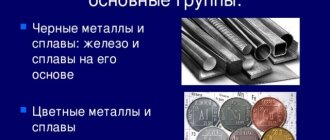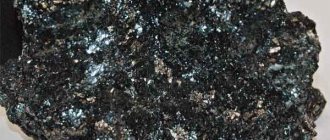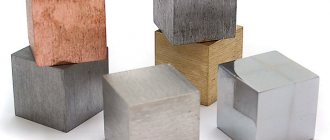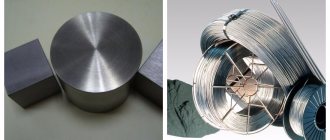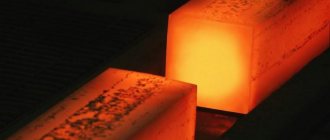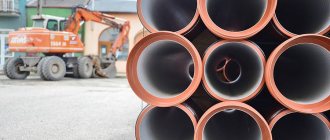Chemical properties of zinc
Zinc Zn is in group IIB of the IV period.
Electronic configuration of valence orbitals of atoms of a chemical element in the ground state 3d104s2. For zinc, only one single oxidation state is possible, equal to +2. Zinc oxide ZnO and zinc hydroxide Zn(OH)2 have pronounced amphoteric properties. Zinc tarnishes when stored in air, becoming covered with a thin layer of ZnO oxide. Oxidation occurs especially easily at high humidity and in the presence of carbon dioxide due to the reaction:
2Zn + H2O + O2 + CO2 → Zn2(OH)2CO3
Zinc vapor burns in air, and a thin strip of zinc, after being incandescent in a burner flame, burns with a greenish flame:
When heated, metallic zinc also interacts with halogens, sulfur, and phosphorus:
Zinc does not react directly with hydrogen, nitrogen, carbon, silicon and boron.
Zinc reacts with non-oxidizing acids to release hydrogen:
Technical zinc is especially easily soluble in acids, since it contains impurities of other less active metals, in particular cadmium and copper. High-purity zinc is resistant to acids for certain reasons. To speed up the reaction, a high-purity sample of zinc is brought into contact with copper or a little copper salt is added to the acid solution.
At a temperature of 800-900oC (red heat), zinc metal, being in a molten state, interacts with superheated water vapor, releasing hydrogen from it:
Zinc also reacts with oxidizing acids: concentrated sulfuric and nitric.
Zinc as an active metal can form sulfur dioxide, elemental sulfur and even hydrogen sulfide with concentrated sulfuric acid.
The composition of the reduction products of nitric acid is determined by the concentration of the solution:
4Zn + 10HNO3(0.5%) = 4Zn(NO3)2 + NH4NO3 + 3H2O
The direction of the process is also influenced by temperature, amount of acid, purity of the metal, and reaction time.
Zinc reacts with alkali solutions, resulting in the formation of tetrahydroxocinates and hydrogen:
When fused with anhydrous alkalis, zinc forms zincates and hydrogen:
In a highly alkaline environment, zinc is an extremely strong reducing agent, capable of reducing nitrogen in nitrates and nitrites to ammonia:
Due to complexation, zinc slowly dissolves in ammonia solution, reducing hydrogen:
Zinc also reduces less active metals (to the right of it in the activity series) from aqueous solutions of their salts:
Zn + CuCl2 = Cu + ZnCl2
Zn + FeSO4 = Fe + ZnSO4
Zinc
To share, click
Zinc is an element of the secondary subgroup of the second group, the fourth period of the periodic table of chemical elements of D.I. Mendeleev, with atomic number 30. It is designated by the symbol Zn (lat. Zincum). The simple substance zinc under normal conditions is a brittle transition metal of a bluish-white color (it becomes dull in air, becoming covered with a thin layer of zinc oxide).
In the fourth period, zinc is the last d-element, its valence electrons are 3d104s2.
Only electrons from the outer energy level participate in the formation of chemical bonds, since the d10 configuration is very stable. In compounds, zinc has an oxidation state of +2.
Zinc is a chemically active metal, has pronounced reducing properties, and is inferior in activity to alkaline earth metals. Exhibits amphoteric properties.
Interaction of zinc with nonmetals
When strongly heated in air, it burns with a bright bluish flame to form zinc oxide: 2Zn + O2 → 2ZnO.
When ignited, it reacts vigorously with sulfur: Zn + S → ZnS.
It reacts with halogens under normal conditions in the presence of water vapor as a catalyst: Zn + Cl2 → ZnCl2.
When phosphorus vapor acts on zinc, phosphides are formed: Zn + 2P → ZnP2 or 3Zn + 2P → Zn3P2.
Zinc does not interact with hydrogen, nitrogen, boron, silicon, or carbon.
Interaction of zinc with water
Reacts with water vapor at red heat to form zinc oxide and hydrogen: Zn + H2O → ZnO + H2.
Interaction of zinc with acids
In the electrochemical voltage series of metals, zinc is located before hydrogen and displaces it from non-oxidizing acids: Zn + 2HCl → ZnCl2 + H2; Zn + H2SO4 → ZnSO4 + H2.
Reacts with concentrated sulfuric and nitric acids to form zinc salt and acid reduction products: Zn + 2H2SO4 → ZnSO4 + SO2 + 2H2O;
- Zn + 4HNO3(conc.) = Zn(NO3)2 + 2NO2 + 2H2O
- 3Zn + 8HNO3(40%) = 3Zn(NO3)2 + 2NO + 4H2O
- 4Zn + 10HNO3(20%) = 4Zn(NO3)2 + N2O + 5H2O
- 5Zn + 12HNO3(6%) = 5Zn(NO3)2 + N2 + 6H2O
- 4Zn + 10HNO3(0.5%) = 4Zn(NO3)2 + NH4NO3 + 3H2O
Interaction of zinc with alkalis
Reacts with alkali solutions to form hydroxo complexes: Zn + 2NaOH + 2H2O → Na2[Zn(OH)4] + H2
when fused, it forms zincates: Zn + 2KOH → K2ZnO2 + H2.
Interaction with ammonia
With gaseous ammonia at 550–600°C it forms zinc nitride: 3Zn + 2NH3 → Zn3N2 + 3H2; dissolves in an aqueous solution of ammonia, forming tetraammine zinc hydroxide: Zn + 4NH3 + 2H2O → [Zn(NH3)4](OH)2 + H2.
Interaction of zinc with oxides and salts
Zinc displaces metals located in the voltage series to the right of it from solutions of salts and oxides: Zn + CuSO4 → Cu + ZnSO4; Zn + CuO → Cu + ZnO.
Zinc(II) oxide ZnO
– white crystals, when heated they acquire a yellow color. Density 5.7 g/cm3, sublimation temperature 1800°C. At temperatures above 1000°C, it is reduced to metallic zinc by carbon, carbon monoxide and hydrogen: ZnO + C → Zn + CO; ZnO + CO → Zn + CO2; ZnO + H2 → Zn + H2O.
Does not interact with water. Exhibits amphoteric properties, reacts with solutions of acids and alkalis: ZnO + 2HCl → ZnCl2 + H2O; ZnO + 2NaOH + H2O → Na2[Zn(OH)4].
When alloyed with metal oxides, it forms zincates: ZnO + MgO → MgZnO2.
When interacting with non-metal oxides, it forms salts, where it is a cation: 2ZnO + SiO2 → Zn2SiO4, ZnO + B2O3 → Zn(BO2)2.
Zinc(II) hydroxide Zn(OH)2
– a colorless crystalline or amorphous substance. Density 3.05 g/cm3, decomposes at temperatures above 125°C: Zn(OH)2 → ZnO + H2O.
Zinc hydroxide exhibits amphoteric properties, easily dissolves in acids and alkalis: Zn(OH)2 + H2SO4 → ZnSO4 + 2H2O; Zn(OH)2 + 2NaOH → Na2[Zn(OH)4];
also easily dissolves in an aqueous solution of ammonia to form tetraamminium zinc hydroxide: Zn(OH)2 + 4NH3 → [Zn(NH3)4](OH)2.
It is obtained in the form of a white precipitate when zinc salts react with alkalis: ZnCl2 + 2NaOH → Zn(OH)2 + 2NaCl.
Characteristics of zinc sulfate
The chemical properties of zinc that we examined earlier, in particular, its reactions with dilute sulfate acid, confirm the formation of an average salt - zinc sulfate. These are colorless crystals, which, when heated to 600° and above, can produce oxosulfates and sulfur trioxide. With further heating, zinc sulfate is converted to zinc oxide. The salt is soluble in water and glycerin. The substance is isolated from solution at temperatures up to 39°C in the form of crystalline hydrate, the formula of which is ZnSO4 × 7H2O. In this form it is called zinc sulfate.
In the temperature range 39°-70°, a hexahydrate salt is obtained, and above 70° only one molecule of water remains in the crystalline hydrate. The physicochemical properties of zinc sulfate make it possible to use it as a bleach in paper production, as a mineral fertilizer in crop production, and as a fertilizer in the diet of domestic animals and poultry. In the textile industry, the compound is used in the production of viscose fabric and in the dyeing of chintz.
Zinc sulfate is also included in the electrolyte solution used in the process of galvanic coating of iron or steel products with a layer of zinc using the diffuse method or hot-dip galvanizing method. A layer of zinc protects such structures from corrosion for a long time. Considering the chemical properties of zinc, it should be noted that in conditions of high salinity of water, significant fluctuations in temperature and air humidity, galvanizing does not give the desired effect. Therefore, metal alloys with copper, magnesium and aluminum are widely used in industry.
Corrosion of zinc in water
Corrosion of zinc in water occurs at temperatures above 55 °C. As the temperature increases, the corrosion rate increases, with a maximum observed at a temperature of 70 °C. After this, the destruction of the metal occurs very slowly. This is due to the formation of corrosion products in water on the surface of zinc. At temperatures up to 55 °C and above 90 – 95 °C, corrosion products have fairly high protective properties, forming a dense continuous film on the surface. The maximum corrosion rate of zinc is explained by the formation of a loose film consisting of Zn(OH)2, which does not have good protective properties, because peels off easily.
In neutral solutions, zinc corrosion occurs with oxygen depolarization.
In sea water, zinc coating of steel can be called quite effective. About 0.03 mm of zinc is consumed per year. The service life of a 0.13 mm thick zinc coating is about 4 – 5 years, which is quite a long time for such an aggressive environment. For aluminum and its alloys in seawater, zinc acts as a protector.
To reduce the rate of corrosion of zinc in an aqueous environment, the following inhibitors are used: sodium silicate and sodium dichromate, sodium hexametaphosphate, lanolin, borax.
Zinc oxide: properties
3D Visualization of Zinc Oxide
A trace element that plays an important role in cell metabolism and stabilization of cell membranes. It is an integral part of many enzyme systems, in which it is either a coenzyme or an integral part of the enzyme. Takes part in the regulation of protein and carbohydrate synthesis. The presence of zinc is a necessary condition for the normal functioning of the immune system. Zinc has a positive effect on memory, promotes the absorption of vitamin A, which is necessary for maintaining vision, facilitates the accumulation of insulin in the body and prolongs its action, and supports the process of tissue repair and wound healing. Zinc is essential for normal growth and reproduction. Zinc deficiency occurs in cases of parenteral treatment without appropriate nutritional supplements, in chronic intestinal diseases (such as colitis and Crohn's disease), in patients with intestinal fistulas, in certain skin diseases (for example, in acrodermatitis enteropathica), less often in the case of cirrhosis of the liver, in renal failure, gastric resection. In cases of zinc deficiency, impaired concentration, taste disturbances, lack of appetite, decreased immunity, poor wound healing, increased blood pressure, hypercholesterolemia, night blindness, prostatic hyperplasia, impaired growth in children are observed, and in cases of significant zinc deficiency - dermatological diseases such such as focal and malignant alopecia. The average zinc content in the body is 1.4–2.3 g, of which about 98% is found inside cells (mainly in red blood cells, skin, sperm, prostate gland, bones, intestinal mucosa). Some zinc compounds (for example, zinc oxide) have astringent and drying properties. Zinc sulfate has anti-inflammatory properties. After oral administration, zinc salts are poorly absorbed from the gastrointestinal tract (by approximately 20–40%). The average concentration of zinc in the blood is 11.3–17.6 mmol/l. Zinc is excreted from the body mainly in feces.
story
Zinc compounds were probably used by early people, in processed and unprocessed forms, as paint or medicinal ointments, but their composition is uncertain. Using pushpanjan
probably zinc oxide, as an ointment for the eyes and open wounds, is mentioned in the Indian medical text Charaka Samhita, thought to date from 500 BC.
or earlier. Zinc oxide ointment is also mentioned by the Greek physician Dioscorides (1st century AD). Galen proposed the treatment of ulcerative cancers with zinc oxide, as did Avicenna in his Canon of Medicine
. Zinc oxide is no longer used to treat skin cancer, although it is still used as an ingredient in products such as baby powder and anti-diaper rash creams, calamine cream, anti-dandruff shampoos, and antiseptic ointments.
The Romans obtained significant quantities of copper (an alloy of zinc and copper) as early as 200 BC. a cementation process where copper reacts with zinc oxide. Zinc oxide is believed to have been produced by heating zinc ore in a shaft furnace. This liberated zinc metal is in the form of steam, which then ascends the chimney and condenses into the form of oxide. This process was described by Dioscorides in the 1st century AD. Zinc oxide is also extracted from zinc mines at Zawar in India, dating back to the second half of the first millennium BC. It was possible also to be manufactured in the same way and used for the production of brass.
From the 12th century zinc and zinc oxide 16 were recognized and produced in India using a primitive form of direct synthesis process. From India, zinc production moved to China in the 17th century. In 1743, the first European zinc smelter was established in Bristol, UK.
The main uses of zinc oxide (zinc white) were in paints and as an additive to ointments. Zinc white was adopted as a pigment in oil painting by 1834, but it also does not mix with oil. This problem was solved by optimizing the synthesis of ZnO. In 1845, Leclerc in Paris was producing oil paint on a large scale, and by 1850, zinc white was being produced throughout Europe. The success of zinc white paint was due to its advantages over traditional white lead: zinc white is essentially permanent in sunlight, it is not blackened by air sulfur, it is non-toxic and more economical. Because zinc white is so "pure" it is valuable for creating shades with other colors, but it makes a rather brittle dry film when mixed with other colors. For example, in the late 1890s and early 1900s, some artists used zinc white as a base for their oil paintings. All of these paintings are developed cracks over the years.
Recently, most zinc oxide has been used in the rubber industry to resist corrosion. In the 1970s, the second largest use of ZnO was photocopying. High quality ZnO produced by the "French process" was added to the transfer paper as a filler. This application was soon supplanted by titanium.
Properties
Physical properties
Thermal conductivity: 54 W/(m K).
Zinc oxide is a direct-gap semiconductor with a bandgap of 3.36 eV. The natural shift of the stoichiometric ratio towards enrichment with oxygen gives it an electronic type of conductivity.
When heated, the substance changes color: white at room temperature, zinc oxide becomes yellow. This is explained by a decrease in the band gap and a shift of the edge in the absorption spectrum from the UV region to the blue region of the visible spectrum.
Chemical properties
Chemically, zinc oxide is amphoteric - it reacts with acids to form the corresponding zinc salts; when interacting with alkali solutions, it forms complex tritetra- and hexahydroxocinates (for example, Na2[Zn(OH)4], Ba2[Zn(OH)6], etc. ):
Zn(OH)3−+OH−⟶Zn(OH)42−⋅{\displaystyle {\ce {- + OH- -> ^2-.}}}
Zinc oxide dissolves in an aqueous ammonia solution, forming complex ammonia:
ZnO+4NH3+H2O⟶Zn(NH3)4(OH)2⋅{\displaystyle {\ce {ZnO + 4NH3 + H2O -> (OH)2.}}}
When fused with alkalis and oxides of some metals, zinc oxide forms zincates:
ZnO+2NaOH⟶Na2ZnO2+H2O;{\displaystyle {\ce {ZnO + 2NaOH -> Na2ZnO2 + H2O;}}} ZnO+CoO⟶CoZnO2⋅{\displaystyle {\ce {ZnO + CoO -> CoZnO2.}}}
When fused with boron oxide and silicon dioxide, zinc oxide forms glassy borates and silicates:
ZnO+B2O3⟶Zn(BO2)2;{\displaystyle {\ce {ZnO + B2O3 -> Zn(BO2)2;}}} ZnO+SiO2⟶ZnSiO3⋅{\displaystyle {\ce {ZnO + SiO2 ->ZnSiO3 .}}}
When mixing zinc oxide powder with a concentrated solution of zinc chloride, a hardening mass is formed quickly (in 2-3 minutes) - zinc cement.
Theoretical material on the topic “Zinc and its compounds” methodological development in chemistry (grade 9)
ZINC AND ITS COMPOUNDS
GENERAL CHARACTERISTICS OF METAL
Zinc is an element of the secondary subgroup of the second group, the fourth period of the periodic table of chemical elements of D.I. Mendeleev, with atomic number 30. The electronic formula in the ground state is 1s22s22p63s23p63d104s2, in the excited state 4s14 p1. In zinc atoms, the d-sublevel is stable and its electrons do not participate in the formation of chemical bonds, therefore the atoms exhibit an oxidation state of +2.
BEING IN NATURE
The element zinc is found in inorganic substances:
- Zinc blende – ZnS
- Zinc spar - ZnCO3
- Zinc spinel – ZnO ∙ Al2O3
PHYSICAL PROPERTIES
A metal of medium activity, under normal conditions it is a brittle transition metal of a bluish-white color (tarnishes in air, becoming covered with a thin layer of zinc oxide).
OBTAINING ZINC
- Pyrometallurgical method - the ore is roasted and the oxide is reduced with coke
2ZnS + 3O2 = 2ZnO + 2SO2; ZnO + C = Zn + CO
- Hydrometallurgical - the ore is treated with a solution of sulfuric acid, and zinc is isolated from the resulting sulfate by electrolysis.
- Electrolysis of zinc salt solutions
ZnSO4 +2H2O Zn + O2 + H2SO4 + H2
CHEMICAL PROPERTIES
Zinc is a metal that forms amphoteric compounds. Zinc compounds ZnO and Zn(OH)2 are amphoteric. Zinc in humid air is covered with a protective, stable hydroxide-carbonate film.
- With non-metals
Zn + S = ZnS
Zn + Г2 = ZnГ2 (Г2 = F, Cl, Br, I)
3Zn + 2P = Zn3P2
- Reacts with acid solutions:
Zn + H2SO4 (dil) = ZnSO4 + H2
- With acids - oxidizing agents:
Zn + 2H2SO4 (conc) = ZnSO4 + SO2 + 2H2O
3Zn + 4H2SO4 (conc) = 3ZnSO4 + S + 4H2O
4Zn + 5H2SO4 (conc) = 4ZnSO4 + H2S + 4H2O
Zn + 4HNO3 (conc) = Zn(NO3) 2 + 2NO2 + 2H2O
4Zn + 10HNO3 (dil) = 4Zn(NO3) 2 + 2N2O+ 5H2O
4Zn + 10HNO3 (very dilute) = 4Zn(NO3) 2 + NH4NO3 + 3H2O
- With alkali solutions:
Zn + 4NH4OH (conc) = [Zn(NH3)4](OH)2 + H2 + 2H2O
Zn + 2NaOH (s) Na2ZnO2 + H2
- With non-metal oxides and ammonia:
3Zn + SO2 2ZnO + ZnS
Zn + CO2 ZnO + CO
3Zn + 2NH3 Zn3N2 + 3H2
- With water (with water vapor when heated)
Zn + H2O ZnO + H2
- With alkaline melt in an alkaline environment
3Zn + KClO3 + 6KOH 3K2ZnO2 + KCl + 3H2O
- With salts
Zn + CuSO4 = ZnSO4 + Cu
Zn + 2Na[Ag(CN)2] (pp) = Na2[Zn(CN)4] + 2Ag
ZINC COMPOUNDS
Zinc oxide ZnO is a loose white powder that turns yellow when heated, is practically insoluble in water, and has amphoteric properties.
Receipt:
- Zn(OH)2 ZnO + H2O
- 2Zn + O2 = 2ZnO
Chemical properties:
Reacts with acids and alkalis, acidic and basic oxides, reduced by coke
- ZnO + H2S = ZnS + H2O
- ZnO + 2NaOH Na2ZnO2 + H2O
- ZnO + N2O5 Zn(NO3)2
- ZnO + SiO2 ZnSiO3
- ZnO + K2O K2ZnO2
- ZnO + C Zn + CO
- ZnO + BaCO3 BaZnO2 + CO2
Zinc hydroxide Zn(OH)2 is a white amorphous substance, insoluble in water, and has amphoteric properties.
Receipt:
Formed by an exchange reaction between a soluble zinc salt and an alkali:
ZnCl2 + 2NaOH = Zn(OH)2 + 2NaCl
Chemical properties
Reacts with acids and alkalis, carbon dioxide, decomposes when heated.
- Zn(OH)2 + 2HNO3 = Zn(NO3)2 + 2H2O
- Zn(OH)2 + 2NaOH (conc) = Na2[Zn(OH)4]
- 2Zn(OH)2 suspension + CO2 = (ZnOH)2CO3 + H2O
- Zn(OH)2 + CaO CaZnO2 + H2O
- Zn(OH)2 + SiO2 ZnSiO3 + H2O
- Zn(OH)2 + 4NH3∙H2O = [Zn(NH3)4](OH)2 + 4H2O
- Zn(OH)2 ZnO + H2O
Zn2+ salts are highly soluble in water and undergo cation hydrolysis.
Zn(NO3)2 + H2O ↔ ZnOHNO3 + HNO3
Zincates are decomposed by acid solutions, when heated or diluted with water.
- Na2[Zn(OH)4] + 2HCl (insufficient) = 2NaCl + Zn(OH)2 + 2H2O
- Na2[Zn(OH)4] + 4HCl (g) = 2NaCl + ZnCl2 + 4H2O
- Na2[Zn(OH)4] + CO2 = Na2CO3 + Zn(OH)2 + H2O
- Na2[Zn(OH)4] (dilution) = Zn(OH)2 + 2NaOH
Zinc sulfide ZnS reacts with acid solutions and is oxidized by atmospheric oxygen when heated (firing):
ZnS + 2HCl = ZnCl2 + H2S
2ZnS + 3O2 = 2ZnO + 2SO2
Dosage
The daily requirement for zinc, depending on age, is: children under 10 years old: 5 mg, children and adolescents 10–15 years old: 15 mg, adults: 15–20 mg. During pregnancy and lactation, the need for zinc increases to 25 mg/day. Acrodermatitis enteropathica, alopecia areata: orally before meals, an average of 45 mg 3 times a day, reducing the dose as the condition improves. The tablets should not be split or chewed. Externally – lubricate sore spots on the skin 1–3 times a day. See also: descriptions of drugs.
Notes
The drug in the form of eye drops may cause temporary visual disturbances, so you should not drive vehicles or operate mechanical equipment immediately after using the drug. Before using drops, you should remove soft contact lenses and put them on at least 30 minutes after use.
Chemical properties of iron
Iron Fe, a chemical element located in group VIIIB and having serial number 26 in the periodic table. The distribution of electrons in the iron atom is as follows: 26Fe1s22s22p63s23p63d64s2, that is, iron belongs to the d-elements, since the d-sublevel is filled in its case. It is most characterized by two oxidation states +2 and +3. FeO oxide and Fe(OH)2 hydroxide have predominant basic properties, while Fe2O3 oxide and Fe(OH)3 hydroxide have noticeably amphoteric properties. Thus, iron oxide and hydroxide (lll) dissolve to some extent when boiled in concentrated solutions of alkalis, and also react with anhydrous alkalis during fusion. It should be noted that the oxidation state of iron +2 is very unstable, and easily passes into the oxidation state +3. Also known are iron compounds in a rare oxidation state +6 - ferrates, salts of the non-existent “iron acid” H2FeO4. These compounds are relatively stable only in the solid state or in strongly alkaline solutions. If the alkalinity of the environment is insufficient, ferrates quickly oxidize even water, releasing oxygen from it.
Interaction with simple substances
With oxygen
When burned in pure oxygen, iron forms the so-called iron scale, which has the formula Fe3O4 and is actually a mixed oxide, the composition of which can be conventionally represented by the formula FeO∙Fe2O3. The combustion reaction of iron has the form:
3Fe + 2O2 =to=> Fe3O4
With sulfur
When heated, iron reacts with sulfur to form ferrous sulfide:
Fe + S =to=> FeS
Or, if there is an excess of sulfur, iron disulfide:
Fe + 2S =to=> FeS2
With halogens
Metallic iron is oxidized by all halogens except iodine to the +3 oxidation state, forming iron halides (lll):
2Fe + 3F2 =to=> 2FeF3 – iron fluoride (lll)
2Fe + 3Cl2 =to=> 2FeCl3 – ferric chloride (lll)
2Fe + 3Br2 =to=> 2FeBr3 – iron bromide (lll)
Iodine, as the weakest oxidizing agent among the halogens, oxidizes iron only to the oxidation state +2:
Fe + I2 =to=> FeI2 – iron iodide (ll)
It should be noted that ferric iron compounds easily oxidize iodide ions in an aqueous solution to free iodine I2, while being reduced to the oxidation state +2. Examples of similar reactions from the FIPI bank:
2FeCl3 + 2KI = 2FeCl2 + I2 + 2KCl
2Fe(OH)3 + 6HI = 2FeI2 + I2 + 6H2O
Fe2O3 + 6HI = 2FeI2 + I2 + 3H2O
With hydrogen
Iron does not react with hydrogen (only alkali metals and alkaline earth metals react with hydrogen from metals):
Interaction with complex substances
With non-oxidizing acids
Since iron is located in the activity series to the left of hydrogen, this means that it is capable of displacing hydrogen from non-oxidizing acids (almost all acids except H2SO4 (conc.) and HNO3 of any concentration):
You need to pay attention to such a trick in the Unified State Examination tasks as a question on the topic to what degree of oxidation iron will oxidize when exposed to dilute and concentrated hydrochloric acid. The correct answer is up to +2 in both cases
The trap here lies in the intuitive expectation of a deeper oxidation of iron (to d.o. +3) in the case of its interaction with concentrated hydrochloric acid.
Under normal conditions, iron does not react with concentrated sulfuric and nitric acids due to passivation. However, it reacts with them when boiled:
2Fe + 6H2SO4 = ot=>Fe2(SO4)3 + 3SO2 + 6H2O
Fe + 6HNO3 =ot=> Fe(NO3)3 + 3NO2 + 3H2O
Please note that dilute sulfuric acid oxidizes iron to an oxidation state of +2, and concentrated sulfuric acid to +3
Corrosion (rusting) of iron
In humid air, iron very quickly rusts:
4Fe + 6H2O + 3O2 = 4Fe(OH)3
Iron does not react with water in the absence of oxygen, either under normal conditions or when boiled. The reaction with water occurs only at temperatures above red heat (>800 °C). those.:
Chemical properties of aluminum
Aluminum is in the third group of the periodic table of elements. The charge of the nucleus of an aluminum atom is +13, there are three electrons in the outer electron layer.
Based on the structure of the atoms and their position in the periodic table, it can be assumed that the metallic properties of the elements of the third group should be less pronounced than those of the elements of the second group. This is true.
During chemical reactions, an aluminum atom gives up three electrons from its outer layer, turning into a three-charged positive ion Al3+. Therefore, in all its stable compounds, aluminum is positively trivalent. Its compounds exhibit amphoteric properties.
Aluminum is a reactive metal and acts as a reducing agent. However, its activity is reduced by the oxide film that forms on its surface. Therefore, in many reactions the film is first removed, and then the reaction with substances occurs. Let's look at the chemical properties of aluminum using specific examples.
- Aluminum combines with oxygen in the air both when heated and at ordinary temperatures. A thin, dense film of aluminum oxide quickly forms on its surface. It is difficult to permeate gases and protects the metal from further oxidation.
In a crushed state and at elevated temperatures, aluminum reacts violently with oxygen, releasing a large amount of heat. As a result, aluminum oxide is formed.4Al + 3O2 → 2Al2O3
- Reactions with many nonmetals occur when heated.
2Al + 3S → Al2S3 Al + P → AlP 2Al + N2 → 2AlN 4Al + 3C → Al4C3 - It interacts with water to remove the oxide film.
The reaction proceeds vigorously, displacing hydrogen from water. 2Al + 6H2O → 2Al(OH)3↓ + 3H2 - Interaction with acids. Place aluminum shavings in a test tube containing hydrochloric or dilute sulfuric acid. Aluminum dissolves, displacing hydrogen from the acid and forming a salt.
2Al + 6HCl → 2AlCl3 + 3H2↑ 2Al +3H2SO4(dil.)→ Al2(SO4)3 + 3H2↑Does not react with concentrated nitric and sulfuric acid. Therefore, concentrated nitric acid is stored in aluminum containers and transported in aluminum tanks.
Reacts with dilute nitric acid to form
N2O, N2 or NH4NO3. 8Al + 30HNO3 → 8Al(NO3)3 + 3N2O + 15H2O
- Since aluminum has amphoteric properties, it is characterized by reactions with alkalis.
2Al + 2NaOH + 10H2O → 2Na[Al(H2O)2(OH)4] + 3H2↑ - Aluminum interacts with the oxides of most metals, displacing the less active metal.
This method is used in industry to obtain metals and is called aluminothermy. 2Al + Fe2O3 → 2Fe + Al2O3
Use of zinc in galvanic cells
The chemical properties of zinc underlie the operating principle of various types of galvanic devices. The manganese-zinc element is the most common in technology. It works by undergoing a redox reaction between the metal and manganese dioxide. Both electrodes are made from them and placed inside the device. The active substance - ammonium chloride - has the form of a paste, or porous plates inserted between the cathode and anode are impregnated with it. The zinc air element is represented by a negative zinc electrode - cathode. The anode is a carbon-graphite rod filled with air. Solutions of ammonium chloride or sodium hydroxide are used as an electrolyte.
Discovery history:
An alloy of zinc and copper - brass - was known in Ancient Greece, Ancient Egypt, India (7th century), China (11th century). For a long time it was not possible to isolate pure zinc. In 1746, A. S. Marggraf developed a method for producing pure zinc by calcining a mixture of its oxide and coal without access of air in clay refractory retorts, followed by condensation of zinc vapor in refrigerators. Zinc smelting began on an industrial scale in the 17th century. The Latin zincum translates as “white coating.” The origin of this word is not precisely established. Presumably, it comes from the Persian “cheng”, although this name does not refer to zinc, but to stones in general. The word "zinc" is found in the works of Paracelsus and other researchers of the 16th and 17th centuries. and goes back, perhaps, to the ancient German “zinc” - plaque, eyesore. The name “zinc” became commonly used only in the 1920s.
Corrosion of zinc in acids
Both zinc of ordinary purity and its oxide corrode when in contact with acids. Very pure zinc does not react with solutions of acids and alkalis even when the temperature rises. The reaction begins only when copper sulfate (CuSO4) is added. Corrosion of zinc is also observed in solutions of alkaline and acidic salts.
In acids and acidified environments, zinc corrosion occurs with hydrogen depolarization, i.e. release of hydrogen.
Corrosion of zinc in hydrochloric acid proceeds intensively, with the formation of zinc chloride and the release of hydrogen according to the reaction:
Zn + 2HCl → ZnCl2 + H2↑.
One of the uses of hydrochloric acid is precisely the production of zinc chloride.
Corrosion of zinc in sulfuric acid also occurs quite intensively, with the formation of zinc sulfate and the release of hydrogen according to the reaction:
Zn + H2SO4(dil.) → ZnSO4 + H2↑.
Redox reactions involving zinc
Since the element comes before hydrogen in the activity series of metals, it is able to displace it from acid molecules.
The reaction products between zinc and acids will depend on two factors:
- type of acid
- its concentration
Dilute sulfuric acid, which does not exhibit pronounced oxidizing properties, reacts with the metal according to the following scheme:
Reactions of the element with phosphoric and dilute sulfuric acids proceed in the same way. The chemical properties and reactions of zinc with nitrate acid have their own characteristics. A dilute solution of nitric acid of average concentration and zinc interact with each other to form nitrogen oxide (II), water and an average salt - zinc nitrate. Concentrated nitrate acid reacts with the metal in such a way that nitric oxide (IV), average salt and water can be detected in the products.
A very dilute solution of nitric acid and zinc as a reducing agent react to form zinc nitrate, water, and several possible products: ammonia, free nitrogen, or nitric oxide.
Atmospheric corrosion of zinc
Corrosion of zinc does not occur in atmospheric conditions. This is due to the formation of a thin protective film of basic zinc oxide – ZnO – on the surface. Zinc is characterized by fairly high corrosion resistance even in the marine atmosphere. The surface is coated with zinc hydroxide and its basic carbon dioxide salts. When exposed to a marine atmosphere, a zinc coating with a thickness of 0.03 mm protects the surface of the product well for eight years.
The industrial atmosphere (with impurities of SO2, SO3, HCl) negatively affects the corrosion resistance of zinc. The service life of a zinc coating of the same thickness is limited to four years. The rural atmosphere does not have any particular negative impact, the service life is about 11 years.
Zinc oxide. Properties and application
Zinc oxide (another name is zinc oxide) is an amphoteric oxide, a crystalline, colorless powder that turns yellow when gradually heated and sublimes at 1800 degrees. Insoluble in water. The oxidation state of zinc in this compound is 2. Chemical formula ZnO
This substance is important for humanity. It has multifaceted effects on the human body
Zinc oxide: physical properties
- Thermal conductivity is 54 W/(m*K).
- It is a semiconductor with a band width of 3.3 eV.
Chemical properties of zinc oxide
- Reacts with acids. In this case, salts are formed.
- Reacts with alkalis to form tetra-, tri- and hexahydroxyzincates.
- This substance dissolves in ammonia aqueous solution. In this case, complex ammonia is formed.
- When fused with oxides and alkalis, zinc oxide forms zincates.
- When fused with silicon and boron oxides, zinc oxide forms silicates and glassy sides.
How is zinc oxide (ZnO) obtained?
Zinc oxide can be obtained in several ways:
- from the natural mineral zincite;
- by burning zinc vapor (Zn) in oxygen (O) - this is the so-called “French process”;
- through thermal decomposition of the following compounds: Zn(OH)2 hydroxide, Zn(CH3COO)2 zinc acetate, Zn(NO3) nitrate, ZnCO3 carbonate;
- during oxidative roasting of ZnS (zinc sulfide);
- during hydrothermal synthesis;
- by extraction from sludge and dust of metallurgical plants. Of particular importance are those plants that specialize in scrap metal containing a significant proportion of galvanized iron.
Applications of Zinc Oxide
Zinc oxide is used in the production of rubber, paper, some plastics, rubber products, artificial leather, electrical cables, glass, ceramics, cosmetics (sunblocks, various cosmetic procedures) and perfumes. It is used as an activator for the vulcanization of various rubbers, a catalyst for the synthesis of organic matter - methanol, a vulcanizing agent for chloroprene rubbers, a pigment and a filler in production. Previously, zinc oxide was needed as a white pigment in the production of enamels and paints, but now it has been completely replaced by TiO2 (non-toxic titanium dioxide). Zinc oxide is also widely used in the paint, tire and oil refining industries.
Zinc oxide has become widespread in medicine and pharmaceuticals (preparations “Zinc Ointment”, “Sudocrem”, “Lassara Paste”). It is used in antiseptic ointments and in the form of powders. In practice, it is used to create bactericidal ceilings and coatings in hospitals and self-cleaning surfaces. Zinc oxide is used to produce toothpastes and cements for therapeutic dentistry. Previously used on an industrial scale for photocatalytic water purification.
The substance we are considering is also used in the production of paints and glass based on liquid glass, as one of the components of a rust remover and as an additive to animal feed. In addition, the powder of this substance is a promising material as a working medium for powder lasers. A blue LED was created based on zinc oxide. And some nanostructures (for example, thin films) based on this substance can be used as biological or gas sensitive sensors.
What effect does zinc oxide have on humans?
Being in nature, receiving:
The most common zinc mineral is sphalerite, or zinc blende. The main component of the mineral is zinc sulfide ZnS, and various impurities give this substance all kinds of colors. Apparently, this is why the mineral is called blende. Zinc blende is considered the primary mineral from which other minerals of element No. 30 were formed: smithsonite ZnCO3, zincite ZnO, calamine 2ZnO·SiO2·H2O. In Altai you can often find striped “chipmunk” ore - a mixture of zinc blende and brown spar. From a distance, a piece of such ore really looks like a hidden striped animal.
Isolation of zinc begins with the concentration of ore using sedimentation or flotation methods, then it is roasted to form oxides: 2ZnS + 3O2 = 2ZnO + 2SO2 Zinc oxide is processed by the electrolytic method or reduced with coke. In the first case, zinc is leached from the crude oxide with a dilute solution of sulfuric acid, the cadmium impurity is precipitated with zinc dust, and the zinc sulfate solution is subjected to electrolysis. Metal of 99.95% purity is deposited on aluminum cathodes.
Chemical properties
Pure ZnO is a white powder, but in nature it occurs as the rare mineral zincite, which usually contains manganese and other impurities that impart a yellow to red color.
Crystalline zinc oxide is thermochromic, changing from white to yellow when heated in air and returning to white when cooled. This color change is caused by a small loss of oxygen to the environment at high temperatures to form non-stoichiometric Zn 1 + xO, where at 800 °C, x = 0.00007.
Zinc oxide is an amphoteric oxide. It is almost insoluble in water, but soluble in most acids such as hydrochloric acid:
ZnO + 2 HCl → ZnCl 2 + H 2 O
Solid zinc oxide also dissolves in alkalis to give soluble zincates:
ZnO + 2 NaOH + H 2 O → Na 2
ZnO reacts slowly with fatty acids in the oil to produce the corresponding carboxylates such as oleate or stearate. ZnO forms cement-like products when mixed with a strong aqueous solution of zinc chloride and they are best described as zinc hydroxyl chlorides. This cement was used in dentistry.
hopeita
ZnO also forms a cement-like material when treated with phosphoric acid; related materials are used in dentistry. One of the main components of zinc phosphate cement produced by this reaction is hopeite, Zn 3 (PO 4 ) 2 4H 2 O.
ZnO, decomposes in zinc and oxygen vapor at about 1975 °C under normal oxygen pressure. In a carbothermic reaction, heating with carbon converts zinc oxide to steam at a much lower temperature (about 950 °C).
ZnO + C → Zn (pair) + CO
Zinc oxide may react violently with aluminum and magnesium powders, chlorinated rubber and linseed oil when heated, causing a fire and explosion hazard.
It reacts with hydrogen sulfide to produce zinc sulfide. This reaction is used commercially.
ZnO + H 2 S → ZnS + H 2 O
Chemical properties of chromium
Chromium is an element of group VIB of the periodic table. The electronic configuration of the chromium atom is written as 1s 22s 22p 63s 23p63d54s1, i.e. in the case of chromium, as well as in the case of the copper atom, the so-called “electron leakage” is observed
The most commonly exhibited oxidation states of chromium are +2, +3 and +6. They should be remembered, and within the framework of the Unified State Examination program in chemistry, it can be assumed that chromium has no other oxidation states.
Under normal conditions, chromium is resistant to corrosion in both air and water.
Interaction with non-metals
with oxygen
Powdered chromium metal, heated to a temperature of more than 600 oC, burns in pure oxygen forming chromium (III) oxide:
4Cr + 3O2 =ot=> 2Cr2O3
with halogens
Chromium reacts with chlorine and fluorine at lower temperatures than with oxygen (250 and 300 oC, respectively):
2Cr + 3F2 =ot=> 2CrF3
2Cr + 3Cl2 =ot=> 2CrCl3
Chromium reacts with bromine at a red-hot temperature (850-900 oC):
2Cr + 3Br2 =ot=> 2CrBr3
with nitrogen
Chromium metal reacts with nitrogen at temperatures above 1000 oC:
2Cr + N2 =ot=> 2CrN
with sulfur
With sulfur, chromium can form both chromium (II) sulfide and chromium (III) sulfide, which depends on the proportions of sulfur and chromium:
Cr + S =ot=>CrS
2Cr + 3S =ot=>Cr2S3
Chromium does not react with hydrogen.
Interaction with complex substances
Interaction with water
Chromium is a metal of medium activity (located in the activity series of metals between aluminum and hydrogen). This means that the reaction takes place between red-hot chromium and superheated water vapor:
2Cr + 3H2O =ot=> Cr2O3 + 3H2↑
Interaction with acids
Chromium under normal conditions is passivated by concentrated sulfuric and nitric acids, however, it dissolves in them upon boiling, while oxidizing to the oxidation state +3:
Cr + 6HNO3(conc.) =to=> Cr(NO3)3 + 3NO2↑ + 3H2O
2Cr + 6H2SO4(conc) =to=> Cr2(SO4)3 + 3SO2↑ + 6H2O
In the case of dilute nitric acid, the main product of nitrogen reduction is the simple substance N2:
10Cr + 36HNO3(dil) = 10Cr(NO3)3 + 3N2↑ + 18H2O
Chromium is located in the activity series to the left of hydrogen, which means that it is capable of releasing H2 from solutions of non-oxidizing acids. During such reactions, in the absence of access to atmospheric oxygen, chromium (II) salts are formed:
Cr + 2HCl = CrCl2 + H2↑
Cr + H2SO4(dil.) = CrSO4 + H2↑
When the reaction is carried out in open air, divalent chromium is instantly oxidized by the oxygen contained in the air to the oxidation state +3. In this case, for example, the equation with hydrochloric acid will take the form:
4Cr + 12HCl + 3O2 = 4CrCl3 + 6H2O
When metallic chromium is fused with strong oxidizing agents in the presence of alkalis, chromium is oxidized to the oxidation state +6, forming chromates: ****
Contraindications
Hypersensitivity to the drug; renal failure. Should not be used externally on wounds that are oozing or covered with scabs. Interaction with other drugs You should not take zinc-containing drugs and tetracycline at the same time (zinc reduces its absorption), as well as iron, calcium compounds, acetylsalicylic acid, indomethacin, thiazide diuretics, chelating agents (D-penicillamine), corticosteroids. Side effects Nausea, vomiting, abdominal pain, diarrhea, headache, metallic taste in the mouth. As a result of long-term use of zinc salts, anemia and copper deficiency in the body may occur.
